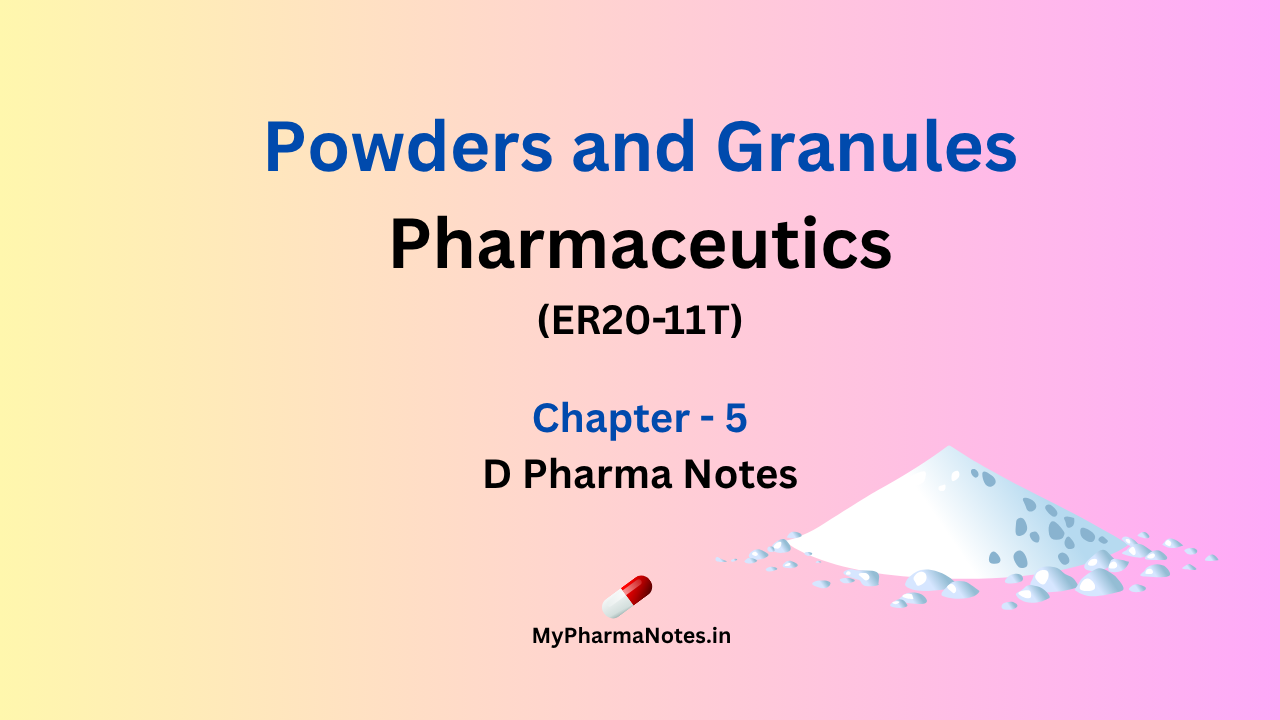Table of Contents
Powders
- A pharmaceutical powder is a mixture of finely divided drug and or chemicals in drug form.
- These are solid dosage form of medicament which are meant for internal and external use.
- They are available in crystalline or amorphous form.
- The particle, chemical and biological properties of the dosage forms.
- There is a relationship between particle size of powder and dissolution absorption and therapeutic efficacy of drugs.
Classification of powders
- Bulk power for external use
- Bulk power for internal use
- Simple and compound powders
- Effervescent granules
- Cachets
Bulk power for external use
- External bulk powders contain non potent substances for external applications.
- These powder are dispensed in glass, plastic wide mouth bottles and also in cardboard with specific method of application.
- Bulk power for external used are of following types:
- Dusting powder
- Insuffiation
- Snuffs
- Douche powder
A. Dusting powder:
- Dusting powder usually contain substance such as zinc oxide, starch and boric acid or natural mineral substances, such as kaolin or talc.
- Talc may be contaminated with pathogenic micro-organisms such as clostridium tetani, etc. And hence it should be sterilized by dry heat.
- Dusting powders should not be applied to broken skin if desired powders should be micronised or passed through a sieve 80 or 100.
- Dusting powders should have adsorption and adsorption capacity.
- They provide protection to the skin against irritation caused by friction moisture or chemical irritations.
B. Insufflation:
- Insuffiations are a class of powders meant for application to body cavities
- Example: Ear, nose, vagina etc.
- The powder has to be extremely fine and must find an entry to the cavity deep enough to bring about its action the site.
- Its is delivered to the effected part in a stream with the help of the device called an insuffiators, which blow the powder to the site.
- Pharmaceutical industry packages the insufflations in pressurized form.
- Example Aerosols.
- Aerosols contain the medication in a stout container with a suitable value the delivery of the powder being accomplished by a liquefied or compressed gas propellant of a very low boiling points.
- On pressing the actuator of the value the propellant delivers the medication in a stream.
C. Snuffs:
- These are finely divided solid dosage forms of medicament which are inhaled into nostrils.
- It contains antiseptics, bronchodilators ,decongestant.
D. Douche powder:
- Douche powders are intended to be used as antiseptics or cleansing agents for a body cavity; most commonly for vaginal use, although they may be formulated for nasal, otic or ophthalmic use also.
- As douche powder formulation often include aromatic oils. it becomes necessary to pass them through a sieve 40 or 60 to eliminate agglomeration and to ensure complete mixing.
- They can be dispensed either in wide mouth glass bottles or in powder boxes but the former are preferred because of protection afforded against air and moisture.
- Example: Douche powder Zinc sulphate Magnesium sulphate Boric acid Lemon oil Purified water
Advantage of powders:
- These are the oldest dosage form used both internally and externally.
- These are more stable than liquid dosage form.
- It is convenient for the physician to prescribe a specific amount of powdered medicament depending upon the need of the patient.
- They are portable.
- The large quantity of drug can be administered easily by dissolving the powdered in an appropriate liquid.
Disadvantages of Powders:
- Drugs having bitter bauseous and unpleasant taste cannot be dispensed in powdered form.
- Deliquescent and hygroscopic drugs can’t be dispensed in powder form.
- Drugs which get affected by atmospheric conditions are not suitable for dispensing in powder forms.
- The dispensing of power is a time consuming.
- Quantity less than 100mg or so cannot be weight convinienty or dispensing balance.
Effervescent Powder:
- Effer vescent powders create a carbonated drink when added to room temperature water.
- Example: Eno, etc.
- This dosage form is useful for patients who don’t tolerate capsules /tablets, who need a high dose of the active ingredient & who need are more palatable flavour for the drug. The combination of the carbonation & the flavour (i.e. mango, passion fruit or raspberry) can override the negative taste of the active ingredient.
Effervescent granules
- Granular solid dosage form consisting of one or more active medicament in a dry mixture usually composed of sodium.
- bicarbonate, citric acid and tartaric acid when added to water the acid and base react to liberate carbon dioxide resulting in effervescences and are administered as carbonated solutions.
Formulation of Granules:
- Active medicaments ex: Antacids, Laxatives, Antibiotics, Antipyretics etc.
- Citric acid and trataric acid.
- Sweetening agent: Sucrose and aspartame
- Colouring agent: Titanium dioxide, tumeric etc.
- Flavouring agent: Peppermint oils, lemon oil etc.
- The effervescent granules (salts) are prescribed to the dispensed in bulk form, no granulation is necessary.
- The ingredients are mixed uniformly and directions stated on the label to add the prescribed quantity to water before use.
Advantage of granules
- They also remove or control dust.
- They increase the compressibility.
- They have good flowability than powders. This feature helps in supplying drug materials easily from the hopper (feeding container) to the die cavities of tablet compression machine.
- Their physical and chemical stability is much more than powders because they have a smaller surface area.
Disadvantages of granules
- Problems in packaging and storage.
- Instability in presence of moisture.
